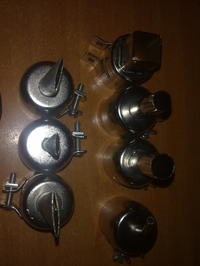Hello, I'm going to learn to solder a bit. Electronics engineer is coming and they don't teach such things in college  I just bought a Hot Air soldering station and I have no problems with soldering with a soldering iron, but I got lost with hot air soldering. I've seen a lot of video tutorials where some solder paste is applied to the pads, then a little magic with air and it's done. I got some flux in gel with flux in the set with the station and I have no idea what it is for. Is that the paste? It looks a little different.
I just bought a Hot Air soldering station and I have no problems with soldering with a soldering iron, but I got lost with hot air soldering. I've seen a lot of video tutorials where some solder paste is applied to the pads, then a little magic with air and it's done. I got some flux in gel with flux in the set with the station and I have no idea what it is for. Is that the paste? It looks a little different.
The second thing is the nozzles. I got 8 of them. 3 round, 3 edged, 1 square and one thin round bent at an angle. Could someone briefly explain which nozzle is best for which systems?
ps please don't yell at me too much if this has already appeared on the forum, I've been looking for 3 days, reading, browsing but I couldn't find answers to my questions.
The second thing is the nozzles. I got 8 of them. 3 round, 3 edged, 1 square and one thin round bent at an angle. Could someone briefly explain which nozzle is best for which systems?
ps please don't yell at me too much if this has already appeared on the forum, I've been looking for 3 days, reading, browsing but I couldn't find answers to my questions.



